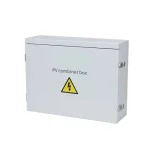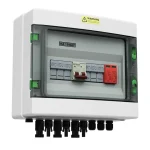Choosing the right inverter and PV combiner box is essential to ensure your solar system performs efficiently and safely. While our previous article — How to Calculate PV Combiner Box Specifications?
— provided a hands-on example, this article dives deeper into How to Match Your Solar Panels with the Right Inverter and Combiner Box for any project size.
If you’re struggling to make decisions about string configurations, MPPT channel allocation, combiner box selection, or inverter sizing, this guide is for you.

Metal Enclosures PV Combiner Box

Plastic Enclosures PV Combiner Box
How to Select an Inverter Based on PV Module Quantity and Specifications
To match your inverter correctly, start by calculating the total power of your solar array:
Total Power (W) = Number of Panels × Power per Panel
For example, with 144 panels rated at 555W each:
144 × 555W = 79,920W
Now compare this with the maximum PV input power supported by your inverter. Choose an inverter with a rated input at least 90–100% of the total array power. Slight oversizing is acceptable within design tolerances.
Also ensure that:
Open-circuit voltage (Voc) per string is below inverter’s max DC input voltage
Operating voltage (Vmp) is within inverter MPPT voltage range
Total current per MPPT does not exceed the MPPT’s rated current
Refer to your module datasheet and inverter manual for these values.
How to Distribute PV Strings According to MPPT Channels
Most commercial inverters come with multiple MPPTs. To maximize energy yield, evenly distribute strings across MPPTs.
For example:
An inverter has 4 MPPTs, and allows 2 strings per MPPT
You can connect 4 MPPT × 2 Strings = 8 Strings
Divide your total panels by the number of strings:
144 Panels ÷ 8 Strings = 18 panels per string
Ensure that 18 × Vmp and 18 × Voc are within the inverter’s voltage limits. Using more strings per MPPT than specified will void the warranty or damage the system.
How to Calculate PV Series-Parallel Configuration
The series-parallel configuration determines the string voltage and total current.
Step-by-step:
Series (per string): Decide the number of panels per string based on voltage (typically 10–20 panels)
Parallel (strings): Number of strings per MPPT
Use the formula:
System Voltage ≈ Vmp × Panels per string
System Current ≈ Imp × Number of strings
Example:
18 panels per string
8 strings total
→ Voltage: 18 × 42.10V = 758V
→ Current: 8 × 13.19A = 105.52A
Confirm that this falls within inverter and combiner box limits.
Should You Use Multiple Small Combiner Boxes or One Large One?
This depends on system size, layout, and installation ease.
Pro tip: Use small combiner boxes if panels are distributed across multiple roofs or arrays. Use a large box if all strings converge near the inverter.
What If My System Is Split Between Rooftop and Wall-Mounted Arrays?
In split systems:
Keep same string configuration across all sections
Use separate combiner boxes for rooftop and wall-mounted arrays
Maintain balanced current input for inverter MPPTs
Install surge protection devices (SPD) on both combiner boxes
Plan for conduit runs, voltage drops, and shading angles. You may need two combiner boxes — one for rooftop, one for wall array — each with 2–4 string inputs.
Why Do Most PV Combiner Boxes Have Only 1 Output?
Combiner boxes consolidate multiple strings into one positive and one negative output for simplicity and safety. Here’s why:
Reduces cable clutter
Simplifies connection to inverter
Avoids uneven current sharing between outputs
Easier for fusing, SPD, and monitoring
If multiple outputs are needed (for redundancy or design), use DC junction boxes or DC load break switches instead.
How to Choose the Right Voltage Rating for the Combiner Box
Your combiner box must withstand the maximum Voc of the string under the coldest expected conditions.
Example:
Voc per panel = 49.95V
18 panels per string → 18 × 49.95V = 899.1V
With 10% safety margin: 899.1V × 1.1 = 989V
Choose a combiner box rated for ≥1000V DC.
Tip: Never exceed the voltage rating. It poses a fire risk and voids certifications.
Summary: How It All Ties Together
In our previous article, we showed how a 144-panel system (each 555W) was paired with:
1 × 80kW inverter (4 MPPTs × 2 strings)
1 × 8-in-1 DLCB combiner box rated for 1000V
This setup:
Balanced strings across MPPTs
Kept voltage and current within limits
Used a single large combiner box for centralized layout
👉 If you haven’t read it yet, we recommend checking out:
How to Select the Right Inverter and PV Combiner Box for Your 144-Panel Solar System
Need Help? Derlicn Can Support Your System Design
At Derlicn Electric, our DLCB series PV combiner boxes are:
CE certified
Designed for 600V/1000V/1500V systems
Available from 2-in-1 to 24-in-1 configurations
Equipped with fuses, SPD, DC switches, and monitoring (optional)
We offer free system consulting. Whether you’re unsure about your string layout or inverter compatibility, our engineers will provide a detailed selection guide tailored to your project.
👉 Contact us now to get a custom system recommendation and quotation.
Table of Contents
Have you Any Questions?
Can’t find an answer to your question, or want more information about our products? If so, please feel free to get in touch with our professional team. We’re here to help you drive your projects to success.
